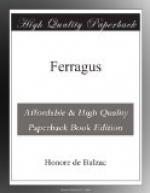INVITA LEGE
CONJUGI MOERENTI
FILIOLAE CINERES
RESTITUIT
AMICIS XII. JUVANTIBUS
MORIBUNDUS PATER.
“What a man!” cried Jules, bursting into tears.
Eight days sufficed the husband to obey all the wishes of his wife, and to arrange his own affairs. He sold his practice to a brother of Martin Falleix, and left Paris while the authorities were still discussing whether it was lawful for a citizen to dispose of the body of his wife.
* * * * *
Who has not encountered on the boulevards of Paris, at the turn of a street, or beneath the arcades of the Palais-Royal, or in any part of the world where chance may offer him the sight, a being, man or woman, at whose aspect a thousand confused thoughts spring into his mind? At that sight we are suddenly interested, either by features of some fantastic conformation which reveal an agitated life, or by a singular effect of the whole person, produced by gestures, air, gait, clothes; or by some deep, intense look; or by other inexpressible signs which seize our minds suddenly and forcibly without our being able to explain even to ourselves the cause of our emotion. The next day other thoughts and other images have carried out of sight that passing dream. But if we meet the same personage again, either passing at some fixed hour, like the clerk of a mayor’s office, or wandering about the public promenades, like those individuals who seem to be a sort of furniture of the streets of Paris, and who are always to be found in public places, at first representations or noted restaurants,—then this being fastens himself or herself on our memory, and remains there like the first volume of a novel the end of which is lost. We are tempted to question this unknown person, and say, “Who are you?” “Why are you lounging here?” “By what right do you wear that pleated ruffle, that faded waistcoat, and carry that cane with an ivory top; why those blue spectacles; for what reason do you cling to that cravat of a dead and gone fashion?” Among these wandering creations some belong to the species of the Greek Hermae; they say nothing to the soul; they are there, and that is all. Why? is known to none. Such figure are a type of those used by sculptors for the four Seasons, for Commerce, for Plenty, etc. Some others—former lawyers, old merchants, elderly generals—move and walk, and yet seem stationary. Like old trees that are half uprooted by the current of a river, they seem never to take part in the torrent of Paris, with its youthful, active crowd. It is impossible to know if their friends have forgotten to bury them, or whether they have escaped out of their coffins. At any rate, they have reached the condition of semi-fossils.




